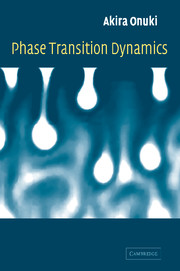4 - Advanced theories in statics
Published online by Cambridge University Press: 13 August 2009
Summary
In this chapter we will present the Ginzburg–Landau–Wilson (GLW) hamiltonian and briefly explain the renormalization group (RG) theory in the scheme of the ∈ = 4 – d expansion [1]–[12]. As unique features in this book we will introduce a subsidiary energy-like variable in addition to the order parameter, discuss GLW models appropriate for fluids, and derive a simple expression for the thermodynamic free energy consistent with the scaling theory and the two-scale-factor universality. We will try to reach the main RG results related to observable quantities in the simplest and shortest way without too much formal argument. In practice, such an approach is needed for those whose main concerns are advanced theories of dynamics. Furthermore, we will discuss inhomogeneous two-phase coexistence and the surface tension near the critical point, near the symmetrical tricritical point, and in polymer solutions and blends. In addition, we will examine vortices in systems with a complex order parameter. These topological defects are key entities in phase-ordering dynamics discussed in Chapters 8 and 9.
Ginzburg–Landau–Wilson free energy
Gradient free energy
When the order parameter ψ changes slowly in space, the simplest generalization of the Landau free energy is of the form, which is called the Ginzburg–Landau–Wilson (GLW) hamiltonian.
- Type
- Chapter
- Information
- Phase Transition Dynamics , pp. 124 - 188Publisher: Cambridge University PressPrint publication year: 2002
- 1
- Cited by



